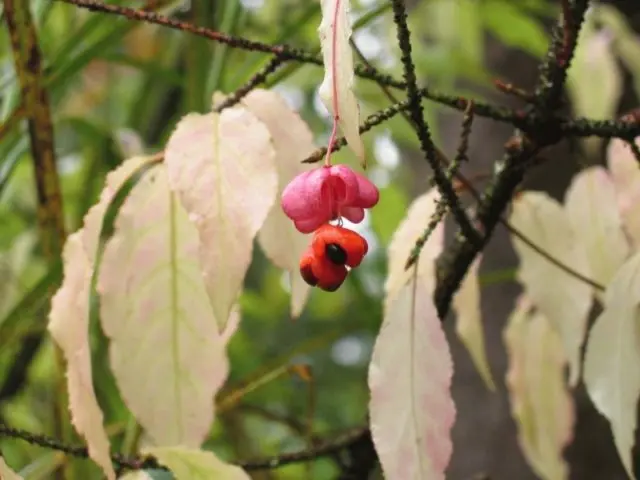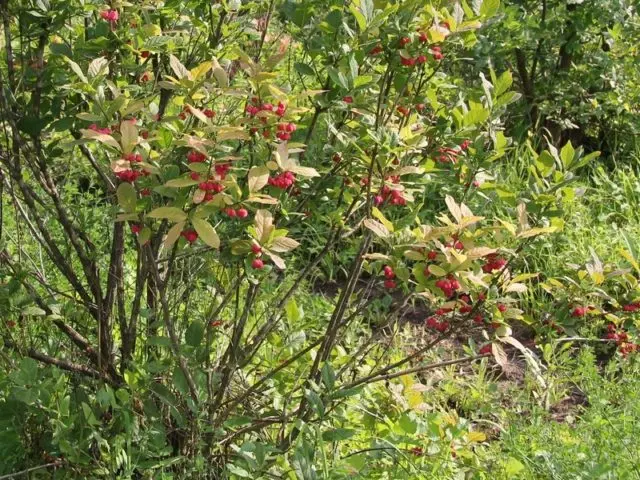Contents
- Description of the European euonymus
- European spindle tree in landscape design
- European euonymus varieties
- European spindle tree: poisonous or not
- Planting and caring for European euonymus in the Moscow region
- European euonymus fruits
- Reproduction of the European euonymus
- Diseases and pests
- European euonymus reviews
- Conclusion
The photo and description of the European euonymus must be studied in order to understand its features. This plant, beloved by many gardeners, is quite unpretentious and common in many regions of Our Country. Compliance with simple rules for care will provide a decorative look of the bush from autumn to winter.
Description of the European euonymus
European spindle tree (in Latin “Euonymus europaeus”) is a deciduous shrub or tree, found wild in Western Europe, in Our Country (in the European part), in the Caucasus and in the Crimea. It can reach a height of 6 m. Young shoots of European spindle tree are painted green, and with age they become almost black, and small growths appear on them.
The leaves are dark green in color, about 10 cm long, ovoid in shape. In autumn, the European euonymus is painted in various shades of red. The plant blooms for about a month, and at this time it does not look very impressive. Semi-umbrella inflorescences include about 5 buds of white, slightly with a greenish tinge, color. The crown of the shrub is dense, but it is most beautiful in autumn – first because of the bright foliage, then because of the fruits that are interesting in shape and color.
European spindle tree in landscape design
Decorative trees and shrubs of European euonymus are actively used in landscape design. They are planted singly or in groups. The plant is often used as a hedge and tolerates pruning well for shaping.

European euonymus varieties
The European euonymus is represented by several varieties that differ in appearance. Each gardener can choose exactly the plant that is most suitable for his site.
Euonymus European Sherwood
It is a shrub up to 5 m in height, having a compact crown and actively forming shoots. Young shoots are rich green, tetrahedral. The leaves resemble an oval, leathery, about 11 cm in size. At the beginning of the season, the shrub is green, but then it turns red-pink. Flowering begins at the end of May and lasts almost three weeks. The Sherwood euonymus has the most decorative appearance during the fruit ripening period – in September. It is covered with bright pink bolls that open to reveal a cascade of seeds with orange seedlings. This is how the shrub looks almost all winter.
Sherwood euonymus grows well on fertile soils of loose structure. Can tolerate light shade, although prefers full sun. The plant is winter-hardy and drought-resistant, so it feels great in the middle zone. It grows intensively, tolerates pruning well.
Euonymus European Red Cascade
A tall shrub, the size of which in adulthood reaches 3,5 m. Sometimes the European euonymus Red Cascade looks like a small tree. The leaves are usually green in summer, and turn crimson red in autumn. Orange fruits also give the European Red cascade euonymus a decorative effect. The plant normally tolerates a transplant, a shaping haircut. This grade is capable is in city conditions, is steady against gas and a smoke. Often used as a hedge. Perfectly complements the tree-shrub composition.
Euonymus European Red cascade is shown in the photo:

At a young age, the euonymus bush is straight, and then acquires a more round and wider shape. Flowering occurs at the end of May – beginning of June. The fruits are red or pink, and when ripe they turn orange. They hang on the bush much longer than the leaves. Euonymus loves the sun, but can also grow in partial shade. It lives well even on acidic soils, but prefers a uniform distribution of moisture.
It tolerates winter well in the climate of the middle zone. The root system is branched and close to the surface, so the bush is sensitive to soil compaction and mechanical damage.
European spindle tree: poisonous or not
European euonymus berries are poisonous, but in order to be poisoned, a person must eat them in large quantities. The plant is widely used in folk medicine – mainly its bark, foliage and seeds are used. Euonymus has a laxative, insecticidal, antimicrobial, antiparasitic, antihelminthic, expectorant and diuretic effect.
Seeds are used for cardiovascular insufficiency, which is associated with their digitalis-like properties. The leaves can be used externally in the treatment of skin affected by fungi. If you suffer from a dry cough, then a decoction of euonymus will help, but when consumed in large doses, it causes poisoning. Infusions in folk medicine also treat migraine, constipation, bronchitis, hepatitis, dysbacteriosis. Powder made from euonymus has an antiparasitic effect and is used for skin diseases.

The leaves contain evonimin glycoside, triglyceride triacetin (helps to increase blood pressure), alkaloids. In the roots and bark of the plant there is a high-molecular hydrocarbon gutta-percha, which is released as a hardening juice. The seeds contain fatty oil.
Planting and caring for European euonymus in the Moscow region
European euonymus is a rather unpretentious plant in care. He feels great in the climate of the Moscow region. Subject to certain rules in cultivation, the shrub will decorate the site and will not cause problems.
European euonymus planting rules
Euonymus seedlings are best purchased in specialized nurseries, so there will be a guarantee that the plant is healthy and of the desired variety. The shrub is capable of self-pollination, but fruit set will be much more effective if it is not alone on the site.
Almost any soil is suitable, but the plant feels best on drained soils with an alkaline reaction. The more lighting there is, the brighter the leaves of the shrub will turn in autumn.
Landing is usually done in the fall, but it can also be done in the spring. The hole should be dug larger, in accordance with the size of the root system of the seedling. Drainage is needed at the bottom: coarse sand or pebbles. A mixture of land for planting is prepared from soddy soil, peat and sand. Peat take two parts, the remaining components one by one. It is also recommended to add lime or dolomite flour. Mineral fertilizers are applied if the soil is poor in nutrients.

At the bottom of the pit, a hill is made and the roots of the European euonymus sapling are spread over it. Then they are sprinkled with the prepared soil mixture. The planted bush must be watered. After compacting the soil, the root neck should remain at ground level.
Watering and top dressing
In the first week after planting, watering should be frequent. Further, the bush needs a large amount of water only during dry periods in the summer. With excessive moisture content in the soil, the plant may begin to rot the roots. After rain or watering, the ground near the trunk should be loosened and sprinkled with peat mulch.
The bush should be fertilized in spring and autumn with mineral compounds. It is also worth periodically adding ash or lime to the soil near the trunk – this reduces the acidity of the soil.
Trimming
The crown of the plant is formed in autumn at the stage of mature fruits or early in spring. After pruning, the bush forms many young shoots.
The top of the shoots is pinched so that the bush grows in the required direction. With sanitary pruning, weak and damaged branches are removed.
Is it possible to transplant the European euonymus
Young seedlings are moved to a permanent place in the 3rd year. Do this in the spring in calm weather, when the soil warms up. Euonymus transplantation cannot be combined with pruning. Bushes that are over 7 years old should not be touched. Such plants do not tolerate transplanting. If the need arose, then the bush is dug up in the spring with a large clod of earth and carefully moved to a new place. The plant should be watered regularly until the leaves bloom.
Preparation for winter
Until the euonymus is 3 years old, it must be covered for the winter, then the plant does not need it. It will be enough to mulch the soil with leaves or sawdust. Even if the ends of the shoots are damaged by frost, then they just need to be cut off in the spring and the bush will quickly restore strength.

Why does the European euonymus not blush
Euonymus is famous for its colorful foliage in autumn. Many people start it on the site precisely because of this feature. But it happens that the leaves are only slightly stained or do not blush at all. This happens because the growing conditions are violated: the bush is planted in the shade or the soil composition is not suitable. In an open sunny place, the plant will have foliage of bright saturated colors.
European euonymus fruits
The fruit is located on a long pedicel and is a 4-lobed box. When ripe, it droops and turns into a rich pink color. At the end of September-October, the fruit opens and seeds appear on thin threads.
Sometimes summer residents complain that the European euonymus does not bear fruit. This can happen due to the lack of pollinators or if the flowers are damaged by spring frosts.
Reproduction of the European euonymus
European spindle tree can be propagated in different ways:
- Seeds. This is the most difficult and longest method. Stratification will be needed, carried out in two stages: first, the seeds are kept for 3 months at a temperature of about +10 ° C, and then at a temperature of +3 ° C. It is necessary to sow the European spindle tree with seeds in a substrate of leafy soil, sand, humus and turf. Young seedlings are protected from frost until they get stronger.
- Cuttings. In July, green shoots are cut into 6 cm cuttings. They are placed in fertile soil mixed with sand, and there they will take root for 45 days.
- Layers. In the spring, low-growing shoots are placed in the soil, in a specially dug groove. The branch itself must be sprinkled with earth and fixed in this position, and the top should be left in the air. Roots will appear soon.
- Root growth. Offspring whose height has reached 40 cm are suitable for these purposes. They must be separated from the mother plant in the spring.
- By dividing the bush. This method is good for undersized varieties. Divided with a spade.

Diseases and pests
The bush is usually attacked by:
- spider mites;
- aphid;
- mealybugs;
- apple moth;
- hawthorn;
- scale insects;
- caterpillars.
You can get rid of pests with the help of insecticidal preparations, such as Actellik or Aktara. Fito-verm or Confidor will help well from the mealybug.
The most common diseases that affect euonymus:
- trunk rot – This is a fungus, with a serious defeat, you can lose the entire bush. The plant is dug up and burned. The treatment with Bordeaux liquid, carried out in the spring, will help.
- Mučnistaâ rosa – The disease is quite common, and responds well to treatment. Use preparations Fundazol or colloidal sulfur.
European euonymus reviews
Conclusion
The photo and description of the European spindle tree indicate that this plant is not dangerous, does not require complex care and will decorate any area. Shrubs with bright foliage are also used in urban landscaping because of its hardiness.









